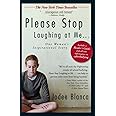In a world where bullying and social isolation continue to plague individuals, the power of storytelling emerges as a potent tool for healing and empowerment. “Please Stop Laughing at Me,” a memoir by Jodee Blanco, encapsulates the transformative potential of sharing one’s experiences. This article explores how Blanco’s narrative not only sheds light on the harrowing realities of bullying but also resonates with readers, prompting reflection and inspiring change.
The Context of Bullying: A National Epidemic

Bullying is not merely a childhood issue; it is a pervasive social problem that can have lifelong consequences. According to the National Center for Educational Statistics, about 20% of students in the United States experience bullying. This staggering statistic indicates that millions of children feel marginalized and isolated daily.
Blanco’s memoir serves as a poignant reminder of the scars left by bullying. Her story of being ostracized and ridiculed throughout her school years highlights the urgent need to address these issues. By recounting her own experiences, Blanco not only validates the feelings of countless victims but also offers a beacon of hope.
The Role of Storytelling in Healing

Storytelling is a powerful medium for expressing emotions and experiences. It allows individuals to articulate their feelings and find community among those who have faced similar struggles. Blanco’s narrative exemplifies how storytelling can help heal emotional wounds and foster resilience.
Empathy Through Shared Experiences
One of the most significant aspects of storytelling is its ability to foster empathy. When individuals share their stories, they create a connection that transcends personal experiences. Readers can relate to the feelings of pain, loneliness, and vulnerability that Blanco evokes.
- Empathy encourages understanding: Readers who may not have experienced bullying can gain insight into the emotional turmoil it causes.
- Shared stories validate feelings: Victims of bullying often feel isolated; hearing another’s story can affirm their own experiences.
- Community building: Storytelling fosters a sense of belonging among individuals who share similar struggles.
Empowerment Through Voice

Blanco’s decision to share her story is not just an act of personal catharsis; it is a bold declaration of her right to be heard. By breaking the silence surrounding her experiences, she empowers others to do the same. This empowerment can lead to:
- Increased self-esteem: Sharing one’s story can help individuals reclaim their narrative and build confidence.
- Encouragement to speak out: When others hear stories of resilience, they may feel inspired to share their own experiences.
- Advocacy for change: Personal stories can mobilize communities to address bullying and create supportive environments.
Case Studies: The Impact of Storytelling on Bullying Awareness

Numerous initiatives have used storytelling as a tool to combat bullying. Let’s examine a few notable examples that illustrate the impact of sharing personal narratives.
The “It Gets Better” Project

Founded in 2010, the “It Gets Better” project is a campaign aimed at uplifting LGBTQ+ youth facing bullying. The initiative encourages individuals to share their stories of triumph over adversity, providing hope to those currently struggling.
Statistics show that the campaign has made a significant impact:
- Over 50,000 videos have been shared, reaching millions.
- Increased visibility of LGBTQ+ issues has led to greater awareness and support in schools.
- Many participants report feeling a sense of community and belonging after sharing their stories.
StoryCorps: Amplifying Voices
StoryCorps is an organization dedicated to recording and sharing personal stories from diverse voices across the country. Their focus on marginalized communities has shed light on issues like bullying and social injustice.
By capturing these narratives, StoryCorps has:
- Provided a platform for individuals to speak about their experiences with bullying and discrimination.
- Encouraged listeners to engage with stories that challenge their perceptions and biases.
- Promoted a culture of listening and understanding, which is essential for combating bullying.
Statistics and Research: The Power of Narratives

The impact of storytelling on bullying awareness and prevention is backed by research. Studies indicate that narratives can significantly influence attitudes and behaviors toward bullying.
- A study published in the journal “Psychology of Popular Media Culture” found that exposure to personal narratives about bullying reduced negative attitudes toward victims.
- Research from the University of California revealed that storytelling interventions in schools led to a decrease in bullying incidents by fostering empathy among students.
- The National Bullying Prevention Center emphasizes that sharing stories can create a culture of acceptance and understanding in schools.
Conclusion: The Enduring Power of Storytelling
“Please Stop Laughing at Me” serves as a powerful testament to the impact of storytelling in addressing the complexities of bullying. Jodee Blanco’s memoir not only sheds light on her personal journey but also resonates with a broader audience, encouraging them to break the silence surrounding their experiences.
Through empathy, empowerment, and community-building, storytelling emerges as a vital tool for fostering understanding and healing. As we continue to confront the realities of bullying, embracing the narratives of those affected can lead to significant change. By amplifying these voices, we create a more compassionate society where no one feels alone in their struggles.
In the end, the stories we share hold the potential to not only heal wounds but also to inspire action and promote a culture of kindness and acceptance.